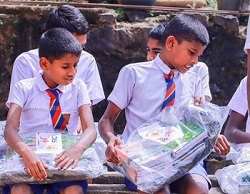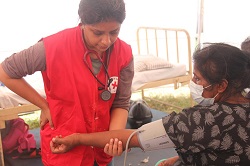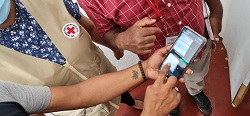Sri Lanka
 In 2022, an economic crisis and a government ban on essential items, including fuel and farm fertilizer, have sparked civil unrest and food insecurity crisis across the country. This comes after decades of conflict, as well as large scale disasters, such as the 2004 Indian Ocean tsunami.
In 2022, an economic crisis and a government ban on essential items, including fuel and farm fertilizer, have sparked civil unrest and food insecurity crisis across the country. This comes after decades of conflict, as well as large scale disasters, such as the 2004 Indian Ocean tsunami.While the country’s civil war that forced hundreds of thousands of people to flee the violence ended in 2009, the Internal Displacement Monitoring Centre (IDMC) estimates that around 11,000 people were still internally displaced at the end of 2021.
Sri Lanka is highly exposed to natural disasters such as droughts, floods, landslides, and cyclones. According to IDMC, more than 121,000 people were displaced internally due to weather related events in 2021, the highest number of internally displaced people recorded in the country since 2017.
In 2004, Sri Lanka was among the countries devastated by the tsunami waves triggered by a 9.0 earthquake off the coast of Indonesia. In Sri Lanka alone, the tsunami claimed more than 30,000 lives and internally displaced half a million people. This crisis prompted one of the largest humanitarian responses in modern days and marked a turning point for emergency preparedness planning and early warning systems.
Sri Lanka today: a complex crisis

The current economic crisis in Sri Lanka has further exacerbated the already dire humanitarian situation with millions of people now facing acute shortages of food, fuel, cooking gas, and medicine. The increasing humanitarian needs have prompted months of peaceful protests that turned violent. The Sri Lanka Red Cross teams are on the ground across all 25 districts of the country and have been providing first aid and ambulance support to people affected by the violence, as well as relief items and cash support to people hit by the economic crisis and food insecurity.
The International Federation of Red Cross and Red Crescent Societies (IFRC) has launched an emergency appeal, which the Canadian Red Cross and Government of Canada have contributed to, to support the Sri Lanka Red Cross Society to provide 500,000 people in the most vulnerable situation with livelihood and basic needs support, safe drinking water and hygiene services.
Canadian Red Cross and Sri Lanka Red Cross Society: a long-standing partnership

The Canadian Red Cross has been partnering with the Sri Lanka Red Cross Society since 1992 but significantly expanded its operations in the country following the devastating 2004 Indian Ocean Tsunami, to respond to the immense humanitarian needs in the country.
The Canadian Red Cross has worked with the Sri Lanka Red Cross and other partners from the Red Cross Red Crescent Movement to support impacted families in areas such as livelihoods, shelter, access to healthcare, and in obtaining essential supplies to rebuild their lives.
Response to the 2004 Indian Ocean tsunami
Since the devastating 2004 tsunami, the Canadian Red Cross has funded more than $63 million in programming to provide immediate emergency relief, and help communities recover, rebuild and prepare for future disasters. A partnership with the Canadian Cooperative Association has supported housing reconstruction projects for communities affected by the tsunami.
- The Canadian Red Cross helped rebuild or repair four damaged hospitals, providing them with new equipment, and built several oxygen storage facilities across the country.
- More than $150 million in donations was directed toward a housing program, where the Red Cross – in collaboration with the Sri Lankan government – supported the construction of houses for 720 families in Sri Lanka
- The Red Cross has invested over $1.3 million in community-based early warning systems across the country.
Working with Sri Lanka’s Ministry of Education, the Canadian Red Cross has also supported violence and abuse prevention programs in schools. The programs for primary and secondary schools aim to reduce sexual and physical abuse, and family violence by involving parents, teachers, students and school administrators in creating environments where children and youth are safe from violence. To date, these programs have educated more than 100,000 children, 212,000 adults and nearly 5,000 primary school teachers across Sri Lanka. Red Cross-trained teachers are now present in almost 20 per cent of Sri Lanka’s government-managed schools.
Read more on child protection as part of programming in Sri Lanka:
Read more on Canadian Red Cross response to the Sri Lanka 2004 tsunami:
- Canadian Red Cross joins efforts to rebuild hospitals destroyed by the tsunami in Sri Lanka
- Canadian Red Cross helps families in need in Sri Lanka
- Journey to the North and North East of Sri Lanka
- Red Cross provides vital support for programs in Sri Lanka
- Sri Lankan city stands tall 10 years after the tsunami
Support to the population affected by the civil war in the North and North East of Sri Lanka
Since 1998, the Canadian Red Cross has delivered a program to provide health promotion for conflict affected communities in Sri Lanka, together with the International Committee of the Red Cross (ICRC).
The end of the civil war in 2009 created an atmosphere of cooperation, and a historic opportunity to address communities’ needs in the spirit of national reconciliation. During the relief efforts, the Red Cross worked with local authorities on both sides of the lines of conflict in order to facilitate the transport of all relief items flowing into the north, including 700 trucks of ICRC relief items.

